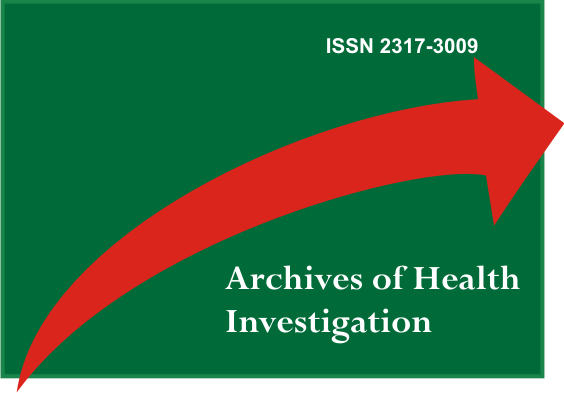Susceptibility of Microorganisms Isolated from Necrotic Pulps to Calcium Hydroxide
Resumo
Calcium hydroxide has been used as pulp-capping agent and canal dressing due to its antimicrobial and anti-inflammatory properties besides its ability to induce formation of mineralized tissues. The aim of this study was to evaluate the susceptibility to calcium hydroxide of 146 bacterial strains isolated from endodontic infections. MIC was determined by using an agar dilution method, while contact bactericide activity was performed through in broth. All the isolates were sensitive to calcium hydroxide in concentrations that varied from 0.5mg/ml to 128 mg/ml, and the genera Enterococcus, Pseudomonas, Staphylococcus and Actinomyces were the most resistant. Gram-negative anaerobes proved to be the most sensitive isolates. All the isolates were inhibited after 60 minutes of contact with the alkali in concentration of 100mg/ml.Keywords: Calcium Hydroxide; Microbial Sensitivity Tests; Infection; Dental Pulp; Bacteria.
Downloads
Referências
Byström A, Happonen RP, Sjögren V, Sundgvist G. Healing of periapical lesions of pulpless teeth after endodontic treatment with controlled asepsis. Endod Dent Traumatol. 1987; 3:58-63.
Adib V, Spratt D, Ng YL, Gulabivala K. Cultivable microbial flora associated with persistent periapical disease and coronal leakage after root canal treatment: a preliminary study. Int Endod J. 2004; 37:542-51.
Peciuliene V, Balciuniene I, Eriksen JM, Haapsalo M. Isolation of Enterococcus faecalis in previously root filled canals in a Lithuanian population. J Endod. 2000;10: 593-5.
Vivacqua-Gomes N, Gurgel-Filho ED, Gomes BPFA, Ferraz CCR, Zaia AA. Recovery of Enterococcus faecalis after single or multiple-visit root canal treatment carried out in infected teeth ex vivo. Int Endod J. 2005; 38:697-704.
Yan MT. The management of periapical lesions in endodontically treated teeth. Aust Endod J. 2006; 32:2-15.
Georgopoulou M, Kontakiotis E, Nakou M. In vitro evaluation of the effectiveness of calcium hydroxide and paramonoclorophenol on anaerobic bacteria from the rrotcanal. Endod Dent Traumatol. 1993; 9:249-53.
Estrela C, Sydney GB, Bammann LL, Felippe Jr O. Mechanism of action calcium and hydroxyl íons of calcium hydroxide on tissue and bacteria. Braz Dent J. 1995;6:85-90.
Suzuki K, Higuchi N, Horiba N, Matsumoto T, Nakamura H. Antimicrobial effect of calcium hydroxide on bacteria isolated from infected root canals. Dent Japan. 1999; 35:43-7.
Han GY, Park SH, Yoon TC. Antimicrobial activity of Ca(OH)2 containing pastes with Enterococcus faecalis in vitro. J Endod. 2001;27: 328-32.
Haenni S, Schmidlin PR, Mueller B, Sener B, Zehnder M. Chemical and antimicrobial properties of calcium hydroxide mixed with irrigating solutions. Int Endod J. 2003; 36:100-5.
Siqueira Jr JF, Lopes HP, Uzeda M. Atividade antibacteriana de medicamentos endodônticos sobre bactérias anaeróbias estritas. Rev Assoc Paul Cir Dent. 1996; 50:326-31.
Siqueira Jr Jf, Uzeda M. Intracanal medicaments: evaluation of the antibacterial effects of chlorhexidine, metronidazole, and calcium hydroxide associated with three vehicles. J Endod. 1997; 23:167-9.
Seabra EJG, Lima IPC, Barbosa SV, Lima KC. Atividade antimicrobiana “in vitro” de compostos a base de hidróxido de cálcio e tergentol em diferentes concentrações sobre bactérias orais. Acta Cir Bras. 2005; 20:12-8.
Barnard D, Davies J, Figdor D. Susceptibility of Actinomyces israelii to antibiotics, sodium hypochlorite and calcium hydroxide. Int Endod J. 1996; 29:320-6.
Estrela C, Sydney GB, Pesce HF, Felippe Jr O. Dentinal diffusion of hydroxyl ions of various calcium hydroxide pastes. Braz Dent J. 1995; 6:5-9.
Buck RA, Cai J, Eleazer PD, Staat RH, Hurst HE. Detoxification of endotoxin by endodontic irrigants and calcium hydroxide. J Endod. 2001; 27:325-8.
Tanomaru JMG, Leonardo MR, Tanomaru Filho M, Bonetti Filho I, Silva LAB. Effect of differnt irrigation solutions and calcium hydroxide on bacterial LPS. Int Endod J. 2003; 36:733-9.
Evans M, Davies J K, Sundqvist G, Figdor D. Mechanisms involved in the resistance of Enterococcus faecalis to calcium hydroxide. Int Endod J. 2002; 35:221-8.
Holland R, Souza V, Nery MJ, Mello W, Bernabe PFE. Root canal treatment with calcium hydroxide. Effect of an oily or a water soluble vehicle. Rev Odontol Unesp. 1983; 12:1-6.
Byström A, Claesson R, Sundqvist G. The antibacterial effect of camphorated paramonochlorophenol, camphorated phenol and calcium hydroxide in the treatment of infected root canals. Endod Dent Traumatol. 1985; 1:170-5.
Orstavik D, Kerekes K, Molven O. Effects of extensive apical reaming and calcium hydroxide dressing on bacterial infection during treatment of apical periodontits: a pilot study. Int Endod J. 1991; 24:1-7.
Estrela C, Mamede Neto I, Lopes HP, Estrela CRA, Pécora JD. Root canal filling with calcium hydroxide using different techniques. Braz Dent J. 2002; 13:53-6.
Leonardo MR, Silveira FF, Silva LAB, Tanomaru Filho M, Utrilla LS. Calcium hydroxide root canal dressing. histopathological evaluation of periapical repair at different time periods. Braz Dent J. 2002; 13:17-22.
Gencoglu N, Külekçi G. Antibacterial efficacy of root canal medicaments. J Nihon Univ Sch Dent. 1992; 34:233-6.
Alaçam T, Ömürlü H, Özkul A, Görgül G, Misirligil A. Cytotoxicity versus antibacterial activity of some antiseptics in vitro. J Nihon Univ Sch Dent. 1993; 35:22-7.
Iordanoglou E, Panopoulos P, Nakou N. In vivo antibacterial effect of calcium hydroxide and camphorated paramonoclorophenol. Int Endod J. 1998; 31:198-9
Haapasalo M, Orstavick D. In vitro infection and disinfection of dentinal tubules. J Dent Res. 1987; 66:1375-9.
Fuss Z, Rafaeloff R, Tagger M, Szajkis S. Intracanal pH changes of calcium hydroxide pastes exposed to carbon dioxide in vitro. J Endod. 1996; 22:362-4.
Chávez de Paz, L. ram-positive organisms in endodontic infection. Endod Topics. 2005; 20:12-8.
Haapasalo HK, Sirén EK, Waltimo TMT, Orstavik D, Haapasalo MPP. Inactivation of local root canal medicaments by dentine: an in vitro study. Int Endod J. 2000; 33:126-31.


